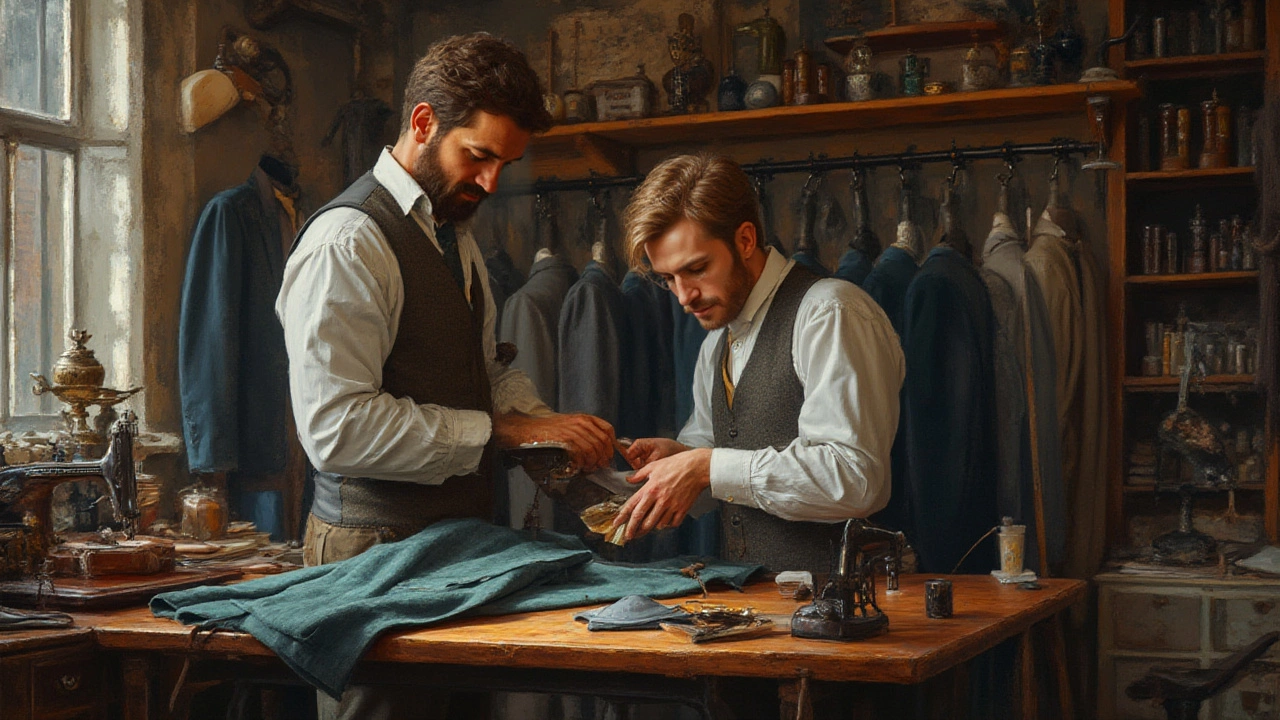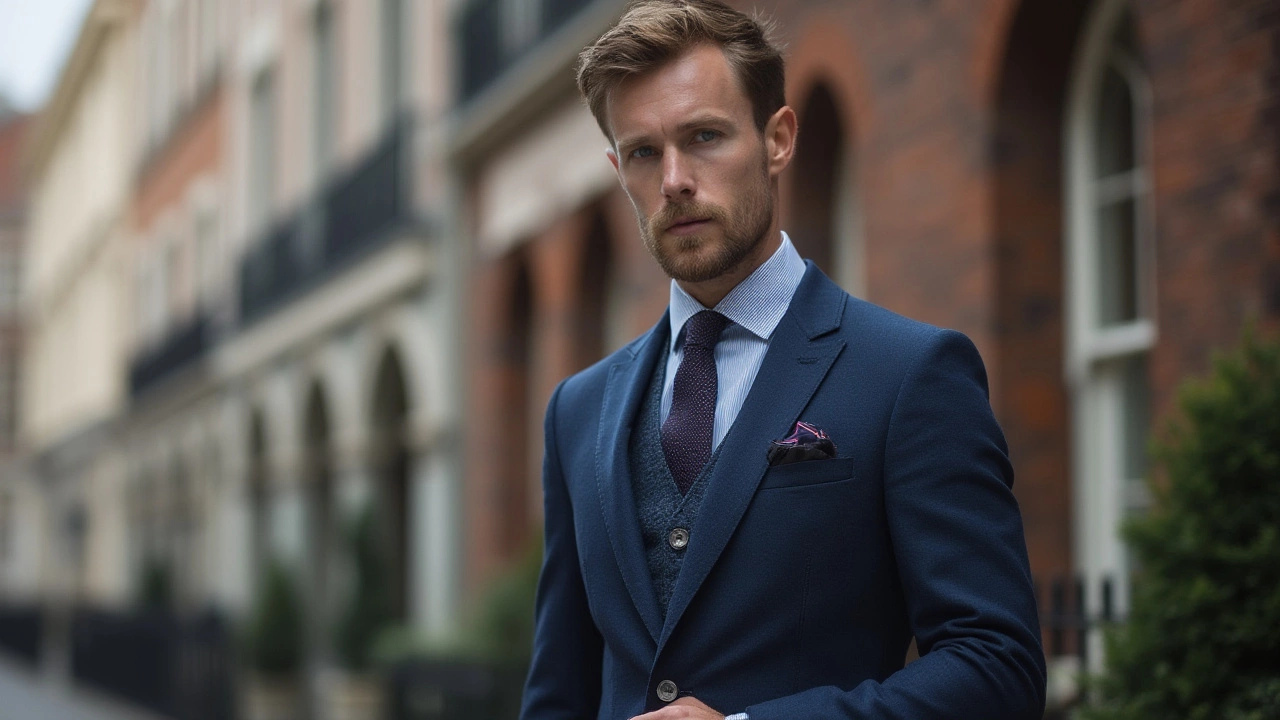Ever tried on a suit in a Dublin shop and wondered if it’s actually worth the price? The Irish market’s packed with sharp displays—from Grafton Street to Cork’s boutique tailors—but figuring out if you’re paying for real quality or just clever branding can feel like a gamble. Knowing how to spot a top-notch suit isn’t just about looking good on GAA Final Day or at a wedding in Galway; it’s about making a smart investment for work, special occasions, and even a pint down the local if the mood strikes. The details set apart a suit that’ll last you years from the one that starts fraying by Halloween.
Irish Fabrics and the Hallmarks of Quality
Start with the fabric. In Ireland, where weather shifts from drizzle to sunshine by lunchtime, the material can make all the difference. High-quality Irish suits usually use pure wool—like Donegal tweed, which has a rustic fleck and warmth that’s practically made for cooler Dublin mornings—or sometimes wool mixes with cashmere or silk if you’re after extra comfort. Steer clear of shiny, cheap polyesters that trap heat and smell after a night out at the Workman’s Club. Next, scrunch a bit of the jacket in your hand and let go. Top wool bounces back, keeping its shape instead of staying wrinkled.
Irish retailers, from Magee 1866 in Donegal to Louis Copeland in the capital, still champion local fabrics. Magee’s handwoven wool has a centuries-old reputation, so you know you’re getting genuine Irish craftsmanship. Look for tight, even weaves with a subtle sheen—not a high-gloss shine, that’s usually a warning sign. Hold the jacket up to the light: a good suit shouldn’t be see-through. Weight is important too. Irish winters bite, so go for something heavier if you’re planning to brave the wind at the Aviva. For summer weddings, a finer weave or linen-wool mix works well—just mind those notorious Galway showers.
Tailoring Details: What to Look For
No matter where you’re shopping—Dundrum, Limerick, or even at a regional Irish designer—look under the bonnet, or in this case, under the lapels. The best suits feature canvassed construction, not glued fusing. Canvassing means a thin layer (often horsehair or cotton) is sewn between the fabric and lining, letting the jacket mould to your body over time. You’ll spot this in suits from places like Louis Copeland, or the higher-end ranges at Brown Thomas. Try feeling between the outer fabric and the lining near the buttons—if you notice a floating, almost spongy layer, that’s canvassing. Glued suits, in contrast, feel stiff and can bubble after a few trips to the dry cleaner.
Inspect the stitching too. Hand-stitched buttonholes will have a slight, irregular look (that’s a good thing), unlike the machine-sewn ones found on cheaper suits. High-quality Irish suits usually boast pick stitching along the lapels and pockets—a subtle detail, but a telltale sign. When you open the jacket, check the lining. Quality suits use durable, breathable materials like viscose or Bemberg. Flimsy, shiny polyester linings are a red flag.
Buttons matter more than you’d think. Real horn or corozo buttons, often seen on Irish luxury brands, feel cool and solid to the touch—plastic is a giveaway of a cheaper make. Functional sleeve buttons (where you can actually undo a few) called “surgeon’s cuffs” are another classic sign of a premium suit.
The All-Important Fit: Made-to-Measure, Off-the-Rack, and Irish Sizing
Let’s talk fit, because not all of us are shaped like GAA midfielders. In the Irish market, fit is where suits either shine or flop. When buying off-the-rack on Henry Street, the shoulders should hug your natural line, never droop over or look pinched. The jacket should sit flat at the back, without bunching near the collar. Sleeves should show just a touch of shirt cuff (a thumb’s width), and trousers should break gently on the shoe—not puddle over it.
Irish brands and retailers know local builds well; it’s not uncommon here for suits to allow a bit more room in the chest and thighs compared to some continental brands. If you’re on the shorter side, Irish tailors like Q. Cumber or The Dublin Tailor can adjust lengths and waists so the whole thing doesn’t swamp you. Made-to-measure, while pricier, often makes sense for Irish men whose builds differ from standard off-the-rack cuts. You’ll get to pick your fabric, lining, lapel style, and even monogramming—useful if you want something that doubles for both a family christening in Kildare and a client meeting in Cork.
One quick tip: try sitting and walking in the suit before you commit. A high-quality suit should move with you, never pulling at the vents or feeling like you’ve strapped yourself into armor. Your tailor should check this too, especially as Irish men tend to need different allowances if they’re cycling to work or spending long days on their feet.

Practical Tips for Buying in Ireland
Price isn’t always proof of quality, but in the Irish suit game, you usually get what you pay for. That said, the January and summer sales at stores like Brown Thomas or Best Menswear can make premium suits far more affordable—so timing your purchase right makes sense. Watch for “suit package” deals outside wedding season, but always check if they’re actually offering quality brands or just clearance lines.
It’s worth visiting independent boutiques where you chat directly with the owner or tailor. In these places, you can usually ask about the suit’s origin, the mill where the fabric was sourced (Ireland, Italy, or the UK), and how the suit is made. You can even spot some rare Irish brands, especially in towns with strong textile traditions like Donegal or Kilkenny. Don’t forget, a real tailor will welcome questions and talk you through weight, breathability, button choices, and lining materials.
Here’s a quick breakdown of practical steps for assessing suit quality while shopping in Ireland:
- Check, scrunch, and feel the fabric—wool is king for Irish climate
- Look for proper canvassing, not glued fusing
- Examine buttonholes, lining, and buttons for quality material and hand-finishing
- Try on the suit and test for fit and movement
- Ask questions about fabric source and construction—Irish-made fabrics are always a plus
- Bring a trusted friend if in doubt; a second eye can spot things you might miss
And remember, alterations aren’t just for perfectionists. Irish bodies can be anything but "standard." Taking in a jacket slightly or hemming trousers might cost a bit, but it makes all the difference. Dublin, Cork, and Galway each have their own tailoring traditions, so it’s almost always possible to find a craftsman to make a good suit perfect for you. Also, keep an eye on events like The Irish Times Fashion Weekend—they’re great places to catch top local tailors at work and get recommendations straight from the source.
Caring for Your Irish Suit: Make It Last
Once you’ve found your high-quality suit, caring for it is key—especially with Ireland’s climate doing its best to put new threads to the test. Never machine wash a proper wool or tweed suit; dry-clean sparingly, as too much can break down the natural fibers. On rainy days, hang your suit on a sturdy wooden hanger and let it dry naturally, far from any hot radiator.
Brush your suit after each wear with a proper garment brush to keep Irish lint, hair, and dust at bay. Invest in a breathable suit bag for storage; plastic ones just trap moisture, which leads to mildew and bad smells, especially in old Irish houses. A quick steam (not iron) before wearing will smooth out any wrinkles—ideal if you’re rushing from a bus or Dart to a big meeting.
Rotate your suits if you wear them often. High-quality wool needs a rest to recover its natural shape, and the typical Irish workweek is hard on clothes. Bring your suit for professional pressing once a season. And don’t forget about your shoes—especially with Irish rain. A battered pair can ruin the look, while good brogues or Oxfords, from local makers like Dubarry or Sanders, elevate it.
Here’s a handy data table for how often Irish men clean and care for their suits, based on a survey of Dublin office workers in 2024:
| Care Activity | Average Frequency |
|---|---|
| Professional Dry Cleaning | Every 4-6 months |
| Brushing at Home | After every 2-3 wears |
| Steam (at home) | Before each wear |
| Suit Rotation | 2-3 suits in regular cycle |
| Shoe Maintenance | Weekly, or after wet weather |
One last local tip: pack a compact umbrella in your briefcase—Dublin rain can ambush the best-dressed. If your suit does get soaked, resist that urge to tumble dry. Wood hangers and patience work wonders for Irish wool.
Making Your Suit Work: Styles and Contexts in Irish Life
Now you’ve cracked the code to spotting a high-quality suit in Ireland, but make sure you’re also picking the right style for where you’ll wear it. Dublin’s city centre is the hub for business suits—solid navy or charcoal is still the gold standard in finance and most offices. For summer weddings in the west, lighter greys or even earth-toned Donegal tweed add a bit of character without feeling out of place. Formal events, like a night at the Abbey Theatre or a family wedding, call for a sharper look: think slim lapels and tailored waistcoats, or even double-breasted if you’re feeling bold.
Double-check local dress codes. At Galway races or university graduations, something with a touch of personality goes down well, but don’t overdo colour or flash. The Irish tradition leans understated. For funerals or official gatherings, stick with darker shades and muted ties.
And don’t forget the importance of a good local alteration. Irish men are known for a preference for comfort—so it’s not unusual to get a suit that gives you room for a pint, then bring it in for a sharper look ahead of an event. Visiting your local tailor a week before a big do for final tweaks is practically a national tradition at this point.
To sum up, if you want your next suit to stand the test of Irish rain, wedding season, and all those long nights out, give fabric, fit, construction, and care the attention they deserve. Brands matter, but so do local shops and a good tailor’s eye. A proper suit isn’t just clothing—it’s a bit of Irish tradition you’ll use time and time again.
